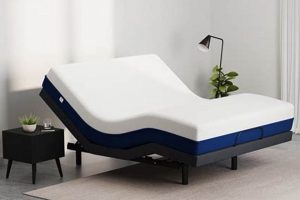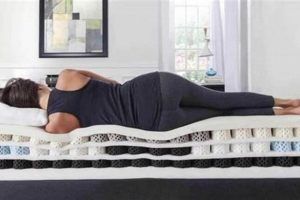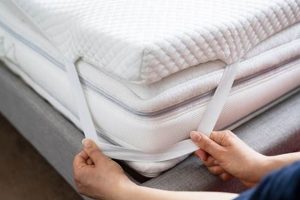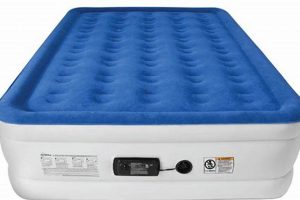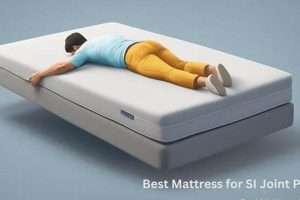A supportive sleep surface engineered to accommodate individuals with higher body weights is a critical component for achieving restful sleep and maintaining spinal alignment. This type of product generally incorporates enhanced support systems and durable materials to withstand greater pressure, preventing premature sagging and ensuring long-term comfort. For example, mattresses with reinforced coil systems or high-density foam cores are often marketed toward this demographic.
The benefits of utilizing a suitable sleep product extend beyond mere comfort. It contributes to reduced pressure point pain, improved circulation, and minimized motion transfer, resulting in fewer sleep disturbances throughout the night. Historically, standard mattresses were not designed to adequately support heavier individuals, leading to discomfort and potential health issues. The development of specialized mattresses addresses this need, promoting better sleep quality and overall well-being.
The following sections will delve into specific mattress types, key features to consider, and materials commonly used in their construction, offering guidance for selecting an appropriate and supportive option.
Selecting a Supportive Mattress
Choosing a mattress designed to provide optimal support and comfort requires careful consideration of several key factors. Prioritizing these elements can significantly improve sleep quality and overall physical well-being.
Tip 1: Consider Innerspring Coils: Opt for mattresses with a robust innerspring coil system. Models with individually wrapped coils minimize motion transfer and provide targeted support to different areas of the body.
Tip 2: Evaluate Foam Density: High-density foam in the comfort layers and support core is crucial for preventing sagging and maintaining shape over time. Look for foam densities of at least 2.0 pounds per cubic foot for optimal support.
Tip 3: Assess Thickness and Height: A thicker mattress, generally 12 inches or more, often provides more substantial support and comfort. Adequate height ensures sufficient layering of materials for optimal performance.
Tip 4: Examine Edge Support: Reinforced edge support prevents the mattress from collapsing along the perimeter, maximizing the usable sleep surface and facilitating easier entry and exit from the bed.
Tip 5: Review Weight Capacity: Always check the manufacturer’s stated weight capacity to ensure the mattress is designed to accommodate the intended user(s) safely and effectively. Exceeding the weight limit can compromise support and shorten the lifespan of the product.
Tip 6: Investigate Hybrid Options: Hybrid mattresses, combining innerspring coils with foam or latex layers, often offer a balance of support, comfort, and pressure relief, making them a viable choice for many individuals.
Tip 7: Prioritize Firmness Levels: A firmer mattress is generally recommended to maintain spinal alignment and prevent excessive sinkage. A medium-firm to firm option will likely be the best choice.
Selecting a mattress with appropriate construction and weight capacity ensures consistent support, minimizes pressure points, and promotes proper spinal alignment, ultimately leading to improved sleep quality and reduced discomfort.
The subsequent sections will explore specific mattress materials and construction methods in greater detail.
1. Reinforced Coil System
A reinforced coil system is a critical structural component in mattresses designed to provide adequate support for individuals with higher body weights. Its design and implementation directly influence the mattress’s ability to maintain its shape, distribute weight evenly, and provide consistent support over time.
- Enhanced Durability and Longevity
A reinforced coil system utilizes thicker gauge steel and/or a higher coil count compared to standard mattresses. This construction provides increased resistance to compression and prevents premature sagging, thereby extending the lifespan of the mattress. Mattresses lacking this reinforcement are more susceptible to wear and tear, potentially leading to discomfort and compromised spinal alignment.
- Improved Weight Distribution
The design facilitates a more even distribution of weight across the mattress surface. This prevents localized sinking and minimizes the development of pressure points, particularly in the hip and shoulder areas. Uneven weight distribution can lead to discomfort, pain, and disrupted sleep patterns.
- Targeted Support and Spinal Alignment
Reinforced zones within the coil system, often located in the lumbar region, provide enhanced support to the lower back. This helps maintain proper spinal alignment, reducing the risk of back pain and promoting a more comfortable sleep posture. Without this targeted support, the spine may be inadequately supported, leading to strain and discomfort.
- Reduced Motion Transfer
Individually wrapped or pocketed coils minimize motion transfer between sleeping partners. This feature is especially beneficial when one partner moves frequently during the night, preventing disturbances and promoting uninterrupted sleep for both individuals. Mattresses with interconnected coil systems tend to transmit motion more readily, potentially disrupting sleep.
The integration of a reinforced coil system directly correlates with the overall suitability of a mattress for heavier individuals. Its ability to provide durable support, distribute weight effectively, promote spinal alignment, and minimize motion transfer makes it a critical feature for enhancing comfort, promoting restful sleep, and extending the lifespan of the mattress.
2. High-density foam core
A high-density foam core serves as a fundamental component in mattresses designed for individuals with higher body weights. The foam’s density, measured in pounds per cubic foot (PCF), directly influences the mattress’s capacity to withstand significant pressure and maintain its structural integrity over time. Low-density foams compress more easily under weight, leading to premature sagging and reduced support. A high-density foam core resists compression, providing a stable and consistent sleep surface. For example, a mattress with a foam core rated at 2.5 PCF or higher demonstrates a superior ability to support heavier individuals compared to a mattress with a foam core rated at 1.5 PCF.
The inclusion of a high-density foam core addresses several practical considerations. Firstly, it minimizes sinkage, ensuring that the sleeper remains adequately supported and aligned. Excessive sinkage can lead to spinal misalignment and pressure point build-up, contributing to discomfort and pain.
Secondly, a high-density core enhances motion isolation, reducing the transmission of movement between sleeping partners. This is particularly beneficial for couples where one or both individuals are heavier, as it mitigates disturbances caused by movement during the night. Finally, the durability of a high-density foam core translates to a longer lifespan for the mattress, making it a more cost-effective investment in the long run.
In summary, the integration of a high-density foam core is a critical factor in determining the suitability of a mattress for heavier individuals. Its capacity to resist compression, provide consistent support, enhance motion isolation, and extend the mattress’s lifespan contributes significantly to improved sleep quality and overall comfort. The higher initial cost associated with high-density foam mattresses is offset by their enhanced durability and long-term performance, making them a worthwhile investment for those seeking a supportive and reliable sleep surface.
3. Enhanced edge support
Enhanced edge support is a critical feature that directly impacts the performance and suitability of a mattress, particularly for heavier individuals. The perimeter of a mattress often experiences concentrated pressure during entry, exit, and when sleeping near the edge. Without adequate reinforcement, the edges can compress and sag, reducing the usable sleep surface and compromising overall support. For heavier people, this issue is amplified, as the additional weight exacerbates edge compression, potentially leading to a feeling of instability and an increased risk of rolling off the bed. Thus, the presence of enhanced edge support becomes a defining characteristic of a high-quality sleep surface designed to accommodate larger body types.
The implementation of enhanced edge support typically involves the use of high-density foam encasements, reinforced coils along the perimeter, or a combination of both. These structural enhancements prevent the edges from collapsing under pressure, maintaining a consistent level of support across the entire mattress surface. Consider, for example, a mattress with standard foam edges compared to one with high-density foam encasement. The standard foam mattress will likely exhibit significant edge compression within a short period, whereas the reinforced edge will maintain its shape and provide a stable seating or sleeping surface. This extended usable surface area is especially advantageous for heavier individuals who may require the full width of the mattress for comfortable positioning.
In conclusion, enhanced edge support is an indispensable component for achieving optimal performance and longevity in mattresses designed for heavier people. Its presence mitigates edge sagging, maximizes the usable sleep surface, and enhances overall stability, contributing to improved sleep quality and reduced discomfort. The absence of robust edge support compromises the mattress’s ability to provide adequate support, potentially leading to premature wear and tear, reduced comfort, and a diminished overall sleep experience. This integration is a non-negotiable characteristic of the best mattress for heavier people, not a mere add-on.
4. Appropriate firmness level
The selection of an appropriate firmness level is paramount when considering a mattress designed for individuals with higher body weights. Firmness directly influences spinal alignment, pressure distribution, and overall sleep comfort, making it a critical factor in achieving restful and restorative sleep. A mattress that is too soft may not provide adequate support, leading to spinal misalignment and pressure point build-up. Conversely, a mattress that is too firm may not conform to the body’s contours, resulting in discomfort and restricted circulation.
- Spinal Alignment and Support
A medium-firm to firm mattress is generally recommended to maintain proper spinal alignment. The additional support prevents excessive sinking, ensuring that the spine remains in a neutral position throughout the night. Real-world examples include individuals experiencing reduced back pain and improved posture after switching to a firmer mattress. For heavier individuals, inadequate spinal support can exacerbate existing back problems and lead to new discomfort.
- Pressure Distribution and Relief
An appropriately firm mattress distributes body weight more evenly, minimizing pressure on sensitive areas such as the hips and shoulders. This can alleviate pressure point pain and promote better circulation. An example of this is the use of pressure mapping technology, which demonstrates how a firmer mattress reduces localized pressure compared to a softer one. For heavier individuals, effective pressure distribution is crucial for preventing pain and promoting comfortable sleep.
- Motion Isolation and Stability
A firmer mattress often provides better motion isolation compared to softer options. This reduces the transfer of movement between sleeping partners, promoting uninterrupted sleep. For instance, couples where one or both partners are heavier may experience reduced sleep disturbances when using a firmer mattress. The stability of a firmer mattress also facilitates easier entry and exit from the bed.
- Long-Term Durability and Sagging Prevention
Firm mattresses tend to resist sagging and compression over time, maintaining their shape and support for longer. This is particularly important for heavier individuals, as a mattress that sags prematurely can compromise support and lead to discomfort. Mattresses constructed with high-density materials and reinforced support systems are better equipped to withstand the additional weight and maintain their firmness over extended periods.
The considerations outlined above highlight the importance of selecting an appropriate firmness level when choosing a mattress. While personal preferences play a role, prioritizing spinal alignment, pressure distribution, motion isolation, and long-term durability is essential for heavier individuals seeking a supportive and comfortable sleep experience. Selecting a firmness level that balances support and comfort is critical for achieving restorative sleep and promoting overall well-being.
5. Durable material composition
The selection of materials plays a crucial role in determining the longevity, support, and overall performance of a mattress, particularly when designed for heavier individuals. Durable material composition is not merely an attribute; it is a fundamental requirement to ensure the mattress can withstand consistent pressure and maintain its structural integrity over time.
- High-Density Foams
The use of high-density foams in the comfort layers and support core is essential for preventing premature sagging and maintaining proper support. Foams with densities of 2.0 pounds per cubic foot (PCF) or higher offer superior resistance to compression and deformation compared to lower-density alternatives. Mattresses utilizing lower-density foams may exhibit significant sagging within a relatively short period, compromis
ing spinal alignment and comfort. For heavier individuals, the selection of high-density foam becomes paramount to ensure the mattress retains its shape and provides consistent support over the long term. - Reinforced Coil Systems
Innerspring mattresses benefit significantly from reinforced coil systems, employing thicker gauge steel and/or a higher coil count. These reinforced coils provide enhanced support and durability, preventing the mattress from bottoming out under significant weight. Pocketed coil systems, where each coil is individually wrapped, minimize motion transfer and offer targeted support to different areas of the body. Without reinforced coils, innerspring mattresses are prone to sagging and uneven support, leading to discomfort and potential back pain.
- Durable Cover Fabrics
The cover fabric is the outermost layer of the mattress and is subject to daily wear and tear. Selecting a durable and breathable fabric is crucial for preventing rips, tears, and excessive wear. Fabrics such as tightly woven cotton, polyester blends, or specialty performance fabrics offer enhanced durability and resistance to damage. A flimsy or low-quality cover fabric can quickly deteriorate, exposing the inner layers of the mattress and reducing its overall lifespan.
- Sturdy Foundation and Frame
While not part of the mattress itself, a sturdy foundation and frame are essential for providing adequate support and preventing premature wear. A weak or inadequate foundation can compromise the mattress’s structural integrity, leading to sagging and reduced lifespan. For heavier individuals, a reinforced platform bed frame or a heavy-duty foundation is recommended to ensure the mattress receives consistent and uniform support.
These carefully selected materials are important considerations in determining whether a mattress is suitable for long-term support and comfort, emphasizing that durable components are essential when it comes to providing adequate support and prolonging the lifespan of the product when dealing with heavier body weights.
Frequently Asked Questions
This section addresses common queries regarding the selection and maintenance of mattresses designed to accommodate individuals with higher body weights. It aims to provide clear and concise information to facilitate informed decision-making.
Question 1: How does weight capacity impact mattress selection?
Weight capacity is a critical specification indicating the maximum weight the mattress is designed to support without compromising its structure or performance. Exceeding the stated weight capacity can lead to premature sagging, reduced support, and a shortened lifespan of the product. It is advisable to select a mattress with a weight capacity that comfortably exceeds the user’s weight to ensure optimal support and durability.
Question 2: What firmness level is generally recommended?
A medium-firm to firm mattress is typically recommended. Softer mattresses may not provide adequate support, leading to spinal misalignment and pressure point build-up. A firmer surface offers greater resistance to compression, promoting proper spinal alignment and distributing weight more evenly. Individual preferences should be considered within this range.
Question 3: Are innerspring mattresses suitable for heavier individuals?
Innerspring mattresses can be suitable, provided they incorporate a reinforced coil system. Thicker gauge steel and a higher coil count enhance the mattress’s durability and support capacity. Individually wrapped or pocketed coils minimize motion transfer and provide targeted support to different areas of the body.
Question 4: What role does foam density play in mattress performance?
Foam density is a key indicator of the foam’s ability to resist compression and maintain its shape over time. High-density foams, typically 2.0 pounds per cubic foot (PCF) or higher, offer superior support and durability compared to lower-density alternatives. The incorporation of high-density foam in the comfort layers and support core is crucial for preventing sagging and ensuring long-term comfort.
Question 5: How important is edge support?
Edge support is essential for maximizing the usable sleep surface and preventing the edges of the mattress from collapsing under pressure. Reinforced edge support, often achieved through high-density foam encasements or reinforced coils along the perimeter, provides a stable and supportive edge for sleeping near the side or sitting on the edge of the bed.
Question 6: What materials contribute to mattress durability?
Durable material composition includes high-density foams, reinforced coil systems, and tightly woven cover fabrics. These materials enhance the mattress’s ability to withstand consistent pressure and resist wear and tear over time. The selection of high-quality materials is a key indicator of a mattress’s potential lifespan and performance.
Selecting an appropriate mattress requires careful consideration of weight capacity, firmness level, coil system, foam density, edge support, and material composition. Prioritizing these factors can significantly improve sleep quality and overall comfort.
The following section will summarize the key considerations and provide recommendations for selecting a suitable mattress option.
Determining the Optimal Sleep Solution
The preceding exploration has underscored the critical factors involved in identifying the most suitable sleep surface for individuals requiring enhanced support. Key considerations include reinforced coil systems, high-density foam cores, enhanced edge support, appropriate firmness levels, and durable material composition. These elements collectively contribute to a mattress’s ability to withstand greater weight, maintain structural integrity, and provide consistent support over an extended period. The absence of these features often results in premature sagging, discomfort, and compromised spinal alignment, negating the potential for restorative sleep.
Selecting a mattress engineered to accommodate higher body weights necessitates a comprehensive evaluation of product specifications and construction methods. By prioritizing durability, support, and appropriate firmness, individuals can invest in a sleep solution that promotes both physical well-being and long-term comfort. Further research and careful consideration of individual needs are encouraged to ensure the chosen mattress aligns with specific requirements and promotes optimal sleep health. Making an informed decision is vital for realizing the full benefits of a supportive sleep system.


